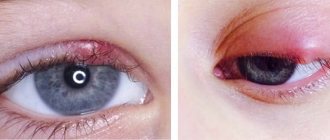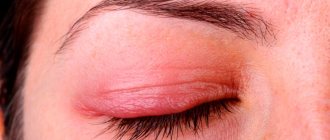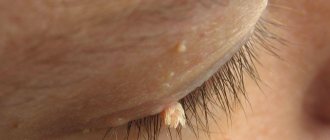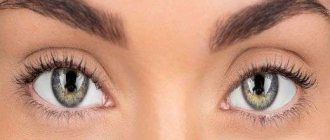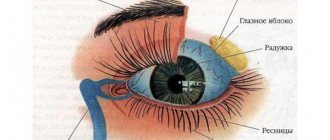What it is?
In medical language, xanthelasma is a benign formation with a smooth or wrinkled texture. The diameter of one plaque can vary between 2-5 mm. Sometimes they gather in “islands” for most of a century. Color ranges from white, yellowish to light orange. They are painless upon palpation and do not interfere with the functions of the eyelids. Suppuration and inflammation of the growth do not occur without physical damage to the surface.
The term "xanthelasma" comes from the Greek words "xanthos" and "elasma" - "golden" and "plate". Most often, middle-aged and elderly women suffer from this defect. The disease affects men a little less frequently. Children are minimally susceptible to such neoplasms. There is no regional connection - xanthelasma is equally common throughout the world. The defect manifests itself suddenly, without other symptoms on the skin. Over time, spots tend to grow; they never resolve on their own.
Plaques on the eyelids often serve as signals of concomitant diseases, for example, atherosclerosis or a pre-infarction condition. They should not be considered a problem of a purely aesthetic nature. Even if xanthelasma does not cause discomfort, the owner needs medical intervention.
What symptoms are you worried about?
Initially, the formation resembles a small wen.
At the initial stages of development, xanthelasma of the eyelids looks like small wen localized around the eye on the skin of the upper and lower eyelids. Over time, the tumor increases in size, most often affecting the eyelids in both eyes. On palpation, soft contents are felt, which ache slightly. The formation is not prone to malignancy, but it brings a lot of discomfort as it constantly increases.
Reasons for development
The process of the appearance of xanthelasma on the eyelids has not yet been fully studied. In most cases, the phenomenon externally reflects a violation of fat metabolism within the body. A comprehensive examination of the patient, as a rule, reveals concomitant pathologies in the form of diabetes, hypertension or obesity.
Fat metabolism can deviate from the norm with age, acquired health problems, and for genetic reasons. The hereditary factor will manifest itself in the form of xanthelasma in the first year of life. In other cases, the appearance of plaques may be a consequence of nephrosis, cirrhosis of the liver, chronic pancreatitis, elevated cholesterol levels, and myxedema.
Sometimes the tumor is purely cosmetic. Then it is associated with a local accumulation of excess sebum, and no general metabolic disorder is observed. This option occurs due to insufficient hygiene - poor cleansing of the dermis from cosmetics, dust, and dirt.
Causes of xanthelasma plaques
The main reason is an imbalance in lipid metabolism - hyperlipidemia, or histiocytosis, which causes cholesterol deposition on the vascular walls, organs and skin.
With histiocytosis, macrophages multiply and devour cells of the immune system, which leads to various biochemical disorders, for example, an abnormal increase in fat deposits.
With hyperlipidemia, cholesterol levels become abnormally high. Cholesterol exhibits two active forms that perform different functions:
- Low-density lipoproteins (LDL) are useful in removing toxins and heavy metals from the body. Triglycerides, which are part of LDL, which form atherosclerotic plaques, are recognized as dangerous substances.
- High-density lipoproteins (HDL) dissolve cholesterol plaques.
With xanthelasma, there is an accumulation of triglycerides, which, when accumulated, form tumors.
What diseases cause xanthelasma? If the disease is caused by genetic pathologies associated with abnormal lipoprotein structures, the disease can develop not only in adults, but in rare cases even in children.
Xanthelasma tumor
Xanthelasma manifests itself against the background of concomitant diseases:
- Obesity;
- Atherosclerosis:
- Coronary heart disease or peripheral vascular disease;
- Diabetes;
- Lack or excess of thyroid hormones;
- Alcohol consumption;
- Liver and kidney failure - 80% of cholesterol is produced by the liver and only 20% comes from food;
- Malignant neoplasms.
With a secondary cause, the prognosis for full recovery is more favorable with the obligatory fulfillment of certain conditions.
Symptoms and diagnosis
Xanthelasma can be unilateral or bilateral. The first option is characterized by localization on one eyelid (usually the upper one), the second is accompanied by symmetrical damage to both eyelids. With severe disorders of lipid metabolism, spread from the inner corner of the eye to the outer corner occurs, with possible involvement of the tissues of the cheeks. In rare cases, the disease is complex with the appearance of small plaques on the neck, lips, and oral mucosa.
Peas and spots do not cause physical discomfort. There are no complaints of redness, scabies, itching, swelling, or inflammation. Doctors determine the presence of systemic symptoms - digestive abnormalities, excess weight accumulation, pressure surges.
The dermatologist performs an initial examination of the eyelids using a glass slide and palpation. Palpation is applied with light pressure to cause blood flow to determine the true shade of the formation. Tumors of the skin and sweat glands are excluded. Next, you need to consult an endocrinologist with blood sampling to check the level of lipoproteins and cholesterol, and a comprehensive examination of metabolism.
Treatment of pathology
Xanthomas appear due to metabolic disorders in the body. If you get rid of the factor that provokes the disease, the skin xanthoma will resolve on its own. The appearance of fatty tumors requires contacting a doctor who will determine the cause of the formation. Until an accurate diagnosis is made, the patient is recommended to adhere to a therapeutic diet and give up bad habits. Medicines are also prescribed to lower cholesterol levels in the body. If the formations are large, surgical removal, laser excision or cryodestruction is prescribed.
Medicines
- drugs of the statin group that lower cholesterol levels and reduce enzyme production - Atorvastatin, Torvazin, Torval, Atomax, Liplimar;
- natural antioxidants that remove excess cholesterol - “Curcumin”, “Transverol”, “Policanzol”
How to delete?
- The cryodestruction method is the removal of xanthoma by sharp freezing to a temperature of -196 degrees using liquid nitrogen.
- Laser treatment is an effective method that helps to qualitatively get rid of pathology using a targeted laser that destroys abnormal cells with high temperature.
- Surgery - removal by a surgeon using a scalpel. To remove the pathology, local anesthesia is used. After the procedure, scar care is necessary.
- Electrocoagulation or radio wave therapy is used for small xanthomas.
Since xanthomas appear due to cholesterol imbalance, it is obvious that the treatment of pathology cannot be done without following a therapeutic diet.
Therapeutic diet
Treatment of xanthoma is carried out in combination with a diet that is aimed at normalizing cholesterol levels. To do this, remove fat-containing foods from the diet, including full-fat dairy products. Alcohol and sweet carbonated drinks are prohibited. In the first weeks of the diet, it is recommended to eat more fruits and vegetables. Then gradually add non-dairy cereals and lean meats with lean fish. The duration of the diet is 30 days. Then you should continue to adhere to a cholesterol-free diet.
How to treat with folk remedies?
- Fish oil and flaxseed oil are natural cholesterol regulators.
- Ascorbic acid - prevents cholesterol synthesis.
- Garlic, dark grapes and cocoa are natural antioxidant products.
- Rosehip decoction with the addition of spruce needles. To prepare the decoction, take 200 g. rose hips and 5 tablespoons of chopped spruce needles and pour 3 cups of boiling water. Infuse for a day and take 2 tablespoons before meals.
Avoiding unhealthy foods and exercising will significantly reduce the risk of developing xanthoma on your body.
How to treat?
After diagnosis, surgical excision, electrocoagulation, and laser therapy may be prescribed. All of these removal methods are aimed at physically destroying and removing excess fat tissue, therefore leaving scars. In addition, on the delicate skin of the eyelids, such an intervention can lead to complications. Therefore, many patients prefer to try alternative treatments at home.
Medicines
The main medications for influencing local fat accumulation are ointments with a resolving effect. Similar drugs are used to smooth out post-operative scars or fresh scars. The leaders in the fight against xanthelasma of the eyelids are ointments:
- mercury yellow 1%,
- zinc-ichthyol,
- hydrocortisone 0.5%.
All options are applied according to the same scheme: rub a small pea into the affected area 2-3 times a day for 2-3 weeks. Avoid contact with mucous membranes.
Folk remedies
There are traditional methods for treating xanthelasma of the eyelids. To reduce cholesterol, it is recommended to take propolis tincture orally. Mix an alcohol solution of 7 drops in 30 ml of water and drink. Take once a day before lunch for 4 months in a row.
Compresses are also believed to give good results.
- Honey. Prepare the dough from 1 egg, 1 tbsp. flour and 1 tsp. honey Form into a pancake or flat cake and apply to the eyelid for 10 minutes. Flour may be needed a little later, depending on the variety. After removing the dough, wash with cool water without soap. Repeat every 1-2 days until the tubercles disappear completely.
- Onion. Bake a medium-sized onion in the oven until soft, chop into a paste. Grate a small piece (about 0.5 cm) of laundry soap on a fine grater and mix with onion. Apply in gauze to the affected area, strictly avoiding contact with the mucous membrane. Do it for 5-10 minutes 1-2 times a day. After removing the compress, wash your face.
- Sour cream. Combine equal parts of sour cream and honey. Add a few crystals of salt. Steam your face. Apply the mixture locally to xanthelasmas. After 10 minutes, rinse with warm water. Repeat every day until resorption.
- Chestnut. Grind 5 baked chestnuts in a meat grinder. Add 1 tbsp. honey and 1 cm of crushed aloe leaf. Apply for 10 minutes. Rinse off with lukewarm water.
- Fatty. 2 tbsp. Melt fat (fresh lard, butter, lamb or goose fat) in a water bath. Cool to a temperature where the product is still hot, but no longer burns the skin. Moisten the gauze and apply a compress for 3-5 minutes. After removing the gauze, massage with light rubbing movements, continuing to wet your fingers with warm fat.
- Wheat. 0.5 tsp Grind the wheat grains into flour, pour in a little vegetable oil (sunflower, sea buckthorn or olive) until the consistency of thick sour cream. Apply for 15 minutes every day until the formation opens. You can replace wheat with whole grain flour.
Medicinal herbs
Herbalists have their own recipes for combating xanthelasma. First of all, it is recommended to take infusions that normalize metabolism, remove excess cholesterol, and destroy excess lipids.
- Yarrow. 2 tsp leave the herbs in 1 cup of boiling water for an hour. Drink 50 ml of the strained drink twice a day before meals for 35 days.
- Collection with mint. Grind 50 g of mint and rosehip each, mix with 30 g of immortelle. 3 tbsp. Boil the mixture in 3 glasses of water until boiling, leave for 6 hours. Strain, take 150 ml 3 times a day. The course lasts 1 month, 8 weeks break, then repeat another round.
- Chamomile. 2 tsp Boil chamomile flowers in 300 ml of boiling water for 10 minutes. Strain. Drink ¼ glass for up to 30 days, three times a day before meals.
- Birch. Boil 20 g of birch buds in a glass of water for 15 minutes over low heat. Drink 2 tbsp. strained broth before breakfast, lunch and dinner for up to 60 days.
- Dandelion. 1 tsp Bring dandelion root to a boil in 300 ml of water. Boil for 10 minutes. Let stand for 1 hour. Drink half a glass 2-3 times a day for 21 days.
Other recommendations
Due to the causes of its occurrence, xanthelasma of the eyelids must be treated comprehensively. If the prerequisites are liver disease, diabetes mellitus or other pathologies, the primary therapy is determined by the doctor. The patient himself must make changes to his usual lifestyle, including the following points:
- Regular thorough hygiene of the eye area, wiping with herbal decoctions, floral waters, green tea using cotton pads.
- Using hypoallergenic high-quality cosmetics for girls, carefully removing makeup before going to bed.
- Careful handling of the area around the eyes during traumatic work, wearing protective glasses (tissue microtraumas lead to local disruption of fat metabolism).
- An active lifestyle with a maximum amount of outdoor walking, swimming, cycling and other aerobic sports, but with a minimum of heavy loads. Lose weight if necessary.
- Diet with limited fat (no more than 75 g of vegetable oil and 25 g of butter per day). It is preferable to get the necessary fats from dairy products, fish, and lean meat. Fruits - at least 200 g, vegetables - at least 300 g per day. Limit potatoes, bread. Avoid alcohol and refined sweets (cakes, candies, white sugar).
- Taking vitamins C, B 4 and 6, nicotinic acid, supporting drugs for the liver (milk thistle extract, Essentiale, etc.). Such substances remove excess cholesterol and even out the composition of the blood.
If xanthelasmas are detected, it is prohibited to squeeze out the tubercles, remove them with a needle, or cauterize them. Independent physical impacts can lead to irreparable consequences with visual impairment. Damage to the plaque with tweezers, scissors or other sharp objects can also lead to bleeding and suppuration.
It has been clinically revealed that xanthelasma itself cannot cause complications other than a cosmetic defect. The neoplasm is not capable of degenerating into a malignant form or causing cancer or other diseases.
The risks in proper treatment boil down to the formation of a small scar after excess fat comes out from under the skin. In addition, a relapse may occur - xanthelasma returns in 90% of cases if it is treated externally and does not affect the normalization of lipid metabolism from the inside.
Why do white spots appear under the eyes?
The appearance of any formations on the eyelids may indicate the presence of undetected pathologies. Xanthelasma of the eyelids is a disease in which yellow, white, and sometimes orange plaques appear on the skin of the eyelids.
In parallel with xanthelasma, diabetes mellitus, hypertension or liver problems are diagnosed. In this article we will tell you why white spots form on the eyelids.
Experts still have not figured out the nature of the formation of spots on the eyelid. The main reasons for the appearance of white plaques on the skin of the eyelid include:
- problems with the pancreas;
- liver pathologies;
- presence of diabetes mellitus;
- obesity;
- metabolic disease;
- lipid metabolism disorder.
Formations can be single or part of a group. As a rule, the disease is located in the corner of the upper eyelid or below.
For information! According to studies, it was found that xanthelasma may indicate a threat of myocardial infarction or the development of atherosclerosis.
In appearance, the plaques have a straw or white color, the surface and contour of the formation are uneven and smooth, and the spot is quite soft to the touch. It is worth noting that xanthelasma is a benign formation that never becomes malignant.
The pathology is more a cosmetic defect than a threat to life.
The size of the spot can be as large as a pea, and in some cases the formation can reach the size of a bean.
Diagnostics
Diagnosis of xanthelasma on the eyelid is carried out by external examination using a glass slide.
The plaque area is slightly pressed with a glass slide so that the formation, its color, shape and structure can be clearly seen.
White spots on the eyelids have characteristic features, so to identify them, a blood test is prescribed, which allows you to determine your cholesterol level.
For information! The level of cholesterol in the blood reflects the presence of a malfunction in lipid metabolism.
The diagnosis is made by a dermatologist and endocrinologist, their examination consists of identifying:
- the root causes of the formation of a white spot;
- determination of xanthelasma or tumor;
- determining the presence or absence of diabetes mellitus or atherosclerosis.
Treatment methods
Treatment of the disease consists of following a diet, namely limiting the consumption of foods containing animal fats.
The main goal of therapy is aimed at eliminating the pathology that provoked metabolic disorders. The diet helps to correct the internal metabolism in the patient’s body.
If the plaques do not go away with diet, your doctor may prescribe their removal.
For information! The formation of recurrence of white spots on the eyelids after removal is completely excluded.
Plaque removal methods include:
- Electrocoagulation - used together with the surgical method; after removing the white spot, its edges are connected to each other and cauterized with an electrode.
- Surgical excision - performed under local anesthesia, plaques are separated using tweezers and scissors. The edges of the spots are connected and lubricated with a solution of iron sesquichloride. The wounds heal within a week after the procedure.
For information! If the edges of the wound are peeled off, they are cauterized with electric current.
- The radio wave method is an absolutely safe procedure, carried out using high-frequency waves, where the instrument used is heated and tumor cells are evaporated with its help. This procedure is non-contact and painless.
- Cryodestruction - the method involves applying liquid nitrogen to the affected area. The temperature of the substance is -195C degrees, the time of application of nitrogen is determined by the attending physician. The main task of nitrogen is to destroy neoplasm cells.
- Laser therapy - the procedure is a gentle removal of formations without gross traces of intervention and injury to nearby tissues. Laser therapy eliminates infection of wounds, the formation of scars or marks after removal, and also eliminates the postoperative period.
You can prevent relapses by following the following dietary regimen:
- limiting carbohydrates;
- exclusion of products containing natural fats;
- inclusion of dairy and plant products in the diet.
In addition to diet, it is recommended to avoid injury at the site of formation of white spots, because It is in previously affected areas that new nodules or tumor-like nodules can form.
For information! Patients suffering from xanthelasma of the eyelid are advised to avoid physical activity.
As a rule, such patients are observed by a therapist to quickly detect the development of early atherosclerosis, coronary heart disease and heart attack. If the xanthomatous white formations on the eyelids are quite dense and have a large area of epidermal damage, the patient is recommended to continue treatment with an ophthalmologist.
The presence of white spots on the skin of the eyelids may indicate serious internal problems. When formations are first detected, it is recommended to undergo an initial examination by your attending physician and undergo the necessary tests.
It is important not to try to cope with it using home methods.
White spots under the eyes, and sometimes on the upper eyelids and other areas of the face, are called milia. Their popular name is millet, due to their external resemblance to millet grains. To the touch, these are dense small formations, small bumps, not painful, but causing aesthetic discomfort. Why do they occur and how can they be removed?
We invite you to familiarize yourself with Endoscopic midface lift
The distribution area of milia is the area under the lower eyelid, but they can also appear around the nose, on the upper eyelids, under the lower lip. They do not change in size, but they do not go away naturally, even if you try to squeeze them out.
White spots under the eyes, similar to pimples, are small subcutaneous formations of white or yellowish color, filled with layered keratin accumulations (keratinized epithelial cells). Their size varies from 0.5 to 2-3 mm, and the points are located in small groups or in the form of separate elements, but never merge with each other.
Of course, you want to get rid of them as quickly as possible, but you need to do this not on your own, but by turning to the services of specialists. Let's talk about the reasons for the formation of milia and methods of removal.
Why do white spots appear under the eyes?
The main reason for the appearance of white dots under the eyes is a violation of the mechanism of exfoliation of dead skin particles.
When this process fails, they accumulate on the surface of the skin, clogging the ducts of the sebaceous glands, which become clogged, and milia appear.
Also, the cause may be excessive activity of the sebaceous glands - owners of excessively oily skin are well aware of this, when excess sebum does not have time to be eliminated.
Other factors that cause millet grains are disturbances in the gastrointestinal tract. Often milia are a consequence of hormonal changes in the body - for example, during puberty, pregnancy or menopause. Another version of the appearance of white spots on the skin around the eyes is exposure to ultraviolet radiation.
Millet is often observed in newborns in approximately 40-50% of cases. In this case, white dots can appear not only on the face, but throughout the body. In infants they disappear in the first 1-3 months of life. The cause is usually a blockage of the sebaceous glands; the child’s body adapts to a new, unusual environment for him.
Patient reviews
- I've had high cholesterol all my life, it's hereditary. New plaques constantly appear on the eyelids. I had it removed by a surgeon, with a laser, and tried compresses and lotions. They still appear. Herbal decoctions are the only thing that at least increases the intervals between relapses. Alina, Moscow .
- I removed xanthelasma surgically. They appeared again. I'm thinking about laser, but I'm afraid. For now I drink propolis and apply zinc ointment. I try to follow a diet, but I love butter, which is fatty, which may be why there is little result. Alexey, Ekaterinburg .
- Growths suddenly appeared on both the upper and lower eyelids. They got bigger and looked ugly. She refused to remove it. They treated the liver and fat metabolism. I follow a strict diet, drink a decoction with mint, and apply hydrocortisone. The plaques have stopped growing and in some places seem to have shrunk. I hope for a more visible result. Galina, St. Petersburg .
Folk remedies
Doctors are quite skeptical about the use of folk remedies to remove xanthelasma. But the use of certain medications may be justified if cholesterol reduction is necessary. This effect can be achieved by:
- Birch buds. Brew 10 g of raw materials with 1 tbsp. boiling water and cook over low heat for 15 minutes. Strain the finished medicine and drink 0.5 tbsp. 3 r. in a day.
- Dandelion root. You can simply grind the dried raw materials in a coffee grinder and take 1 tbsp. l. 3 r. per day for 1 month. The product has a bitter taste, so it can be used together with honey.
- Rose hips. Grind the raw materials in a mortar and pour boiling water at a ratio of 1:6. Leave in a thermos for 6-8 hours, then strain through gauze folded in several layers. Take 0.5 tbsp. 3 r. per day, sweetened with honey.
- Corn silks. 3. art. l. dry raw materials, brew 200 ml of boiling water and place in a water bath under a lid for a quarter of an hour. Then remove the broth from the stove and leave for another 46 minutes. Strain the finished medicine, dilute 1 tbsp. water and take 3 tbsp. l. at intervals of 4 hours.
- Plantain juice. This remedy should be taken 1 tbsp. l. 3 r. per day in about 15 minutes. before the meal. It is best to prepare plantain juice from the leaves of the upper part of this plant.
- Immortelle flowers. 1 tbsp. l. dry raw materials, brew 0.5 liters of cold water and put on fire. Remove from heat immediately after boiling and leave covered for 4 hours to steep. Take 0.5 tbsp. 3 r. in a day.
It is worth considering that all traditional medicine can provoke allergic reactions, in addition, they have contraindications for use. In particular, the above plants cannot be used if there are disorders of bile drainage along the biliary tract.
What is xanthelasma (xanthoma) of the eyelids: what does it look like, is it dangerous, can it be cured?
Some people, especially older people, notice the appearance of a lump on the skin near the eyes, resembling a wart or a hanging mole, only yellow in color. This formation is called xanthelasma of the eyelids and is benign. It does not require special treatment, but when it reaches a large size it can cause discomfort. Xanthelasma can be removed by a surgeon.
You can quickly and easily get rid of xanthelasma!
9 most powerful remedies!
These simple remedies are gentle and effective!
Only those who have xanthelasma know how annoying it is.
It is a slightly yellowish, flat, benign growth that appears on the top of the eyelids.
This is quite unsightly in appearance and affects a person's self-esteem.
To determine that the resulting plaque is actually xanthelasma, you should study the lipid spectrum of the blood.
If the test is positive, steps should be taken to reduce blood lipids and cholesterol levels to normal levels.
Women are more likely to suffer from this evil, and the older they are, the more common it can be.
Some practitioners believe that xantholasma could be considered a symptom of severe atherosclerosis or would indicate a high risk that the patient is suffering from heart attacks.
However, the reasons for this problem are not known.
Xanthelasma is often observed in patients with obesity, diabetes, myxedema, nephrosis lipoids, pancreatitis, liver cirrhosis and high blood cholesterol. It may be hereditary. In these cases, a genetically determined disorder of fat metabolism develops.
As a rule, xanthelasma appears on both eyelids. Sometimes it merges into a solid yellow stripe with an uneven contour, passing through the entire upper eyelid.
Its development occurs gradually and slowly, without subjective sensations in the patient. It can be the size of a small pea to the size of a bean.
To eliminate it, you can try the following natural remedies:
Symptoms of the disease
Xanthelasma is a slightly raised yellowish plaque that is usually located on the upper eyelid near the corner of the eye. The formation does not cause pain when pressed and has a soft consistency.
Plaques can be single or multiple (sometimes they merge to form tuberous elements). In some cases, such formations are combined into a continuous strip, which has an uneven contour and runs across the entire eyelid.
Xanthelasma multiplex
Plaques form suddenly without previous skin changes.
They develop quite slowly and do not cause any discomfort to the patient. The size of xanthelasma varies from 2 mm to 5 cm. The resulting formations remain on the eyelid throughout the patient’s life, gradually increasing in diameter. If xanthelasma appears against the background of xanthomatosis, then it may be accompanied by damage to the lower eyelid by xanthomas. Such pathological formations can also appear on the face, neck, knee and elbow joints, and lips.
Features of treatment at home
There is no strictly developed treatment regimen for xanthelasma as such. An integrated approach, according to doctors, should include the following therapeutic areas:
- Taking medications that normalize lipid metabolism. Products with herbal ingredients give good results. Livial is considered an effective drug with a pronounced lipotropic effect.
- Use of local products. The active components have a destructive effect on xanthomatous formations, as a result of which the plaques quickly resolve. Zinc-ichthyol ointment has proven itself to be the best. Hydrocortisone ointment has a good effect.
Use of decoctions of medicinal herbs. Thanks to traditional medicine recipes, the normal functioning of the digestive and biliary system is restored without loading the body with potent medications. Medicinal herbs activate metabolic processes, remove excess bile from the body, and improve immunity.
- Diet food. It is impossible to normalize fat metabolism without following a strict diet. Proper nutrition will improve the functioning of the gastrointestinal tract, protect against obesity and, of course, be a good prevention of xanthelasma.
If the disease has acquired an extremely advanced form, then no conservative treatment methods, in particular folk remedies, can save you from xanthelasma on the eyelids. Only surgical intervention will help here (surgical excision, electrocoagulation, laser removal, cryodestruction, radio wave destruction).
